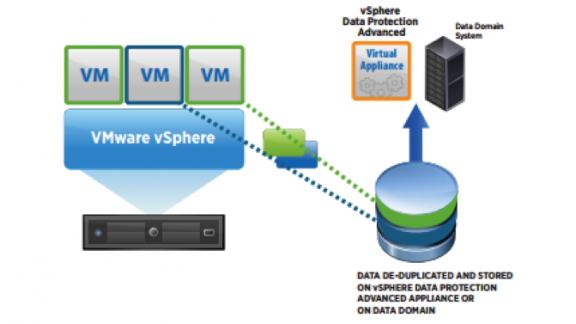As of March 1, 2015, VMware vSphere Data Protection (vDP) and VDP Advanced (VDPA) were consolidated into one product. Now VDPA is included in the vSphere Essentials Plus Kit or higher vSphere editions, all vSphere with Operations Management editions, and all vCloud Suite editions.
One of my customers who runs more than 5,000 virtual machines on vCloud Suite Advanced asked me to investigate some details on VDPA and its integration with EMC Data Domain. I thought I would share some details on the nature of the question and my findings—from multiple sources—in one place. Thank you to the EMC and VMware specialists who assisted me in this quest!
The first question some readers will have is, “Why would an enterprise-scale customer use VDPA?” The typical assumption is that VDPA is for smaller organizations or branch offices, those with 100 virtual machines per appliance, and a maximum 10 VDPA appliances per vCenter Server instance.
The answer to that question is: The enterprise-level backup software offered by VMware partners who integrate with vSphere will allow fast and scalable backup (and restore) operations. There are two constraints here:
- The enterprise backup software license limits the number of virtual machines (or the amount of data being backed up). This means only highly important workloads are being backed up to make sure the software is licensed in an efficient way.
- In large organizations, the backup admin and vSphere admin are not the same person. In my customers’ case, these two admins work for different departments and are located in different buildings across the city. When a new virtual machine is added to the pool and needs to be backed up, the communication and change management process is not simple.
What my customer wanted to achieve:
- Flexibility – The customer’s infrastructure department needed to backup non-critical workloads on their own, when needed.
- Agility – Make changes to what gets backed up—and when—on very short notice without going through all inter-department communication channels.
- Cost-effectiveness – Not to waste expensive enterprise-grade backup licenses on workloads that can be backed up by VDPA (which the customer already owns as part of their vCloud Suite).
It was still a concern that 100 virtual machines per appliance, and the performance that VDPA provides to a small/medium businesses and remote offices might not suit the needs of the enterprise-scale customer.
The customer became creative and asked, “What if we use EMC Data Domain in Conjunction with VDPA?”
You can read more on the integration between EMC Data Domain and VDPA in Jeff Hunter’s blog.
The main benefit of this solution is higher performance of EMC Data Domain as a target device for VDPA backup. What it provides to my customers is an increased limit of virtual machines per VDPA that can be backed up, and enterprise-grade speed of the backup (and restore) process. Details can be found here. Below is a short quote from the document on scalability of the solution.
Additionally, VDPA can be used to backup applications, and has specific agents for Microsoft SQL and Microsoft Exchange to provide granular backup and restore of your data.
If you were under the impression that VDPA is not for you – please (a) review your business case, and (b) have a look to see how VDPA can benefit your organization; you might already have it as a part of the vSphere bundle your company purchased.
VMware offers excellent, FREE, Hands-On Labs on a great number of topics.
Look for HOL-SDC-1405 (IT Outcomes – High Availability and Resilient Infrastructure) – it is an excellent lab on this topic. Section #3 (Data Backup and Recovery with VMware vSphere Data Protection) covers VDPA and will help you understand the solution in minutes.
Petr McAllister is a VMware Technical Account Manager based out of Vancouver, British Columbia, Canada.







